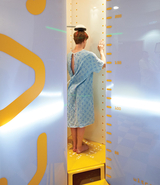EOS X-ray Imaging System
What is EOS?
The EOS Imaging System is a low-dose, 3-D imaging system that scans your child standing up. An EOS scan shows us your child's natural, weight-bearing posture and allows us to see the interaction between the joints and the rest of the musculoskeletal system, particularly the spine, hips and legs.
What are the benefits of EOS imaging?
EOS imaging uses an ultra-low dose of radiation to provide extremely detailed, high-quality images. It uses a significantly lower radiation dose than a general radiography X-ray. With EOS scans, we can make more informed diagnoses and create individualized treatment plans for children with musculoskeletal disorders.
Reduced radiation dose
We take every safety precaution and have set the standards for reducing children's exposure to radiation across all imaging tests and procedures. The EOS technology is yet another tool that enables us to provide the best imaging services while reinforcing our commitment to safety and low-dose imaging options for our patients.
- EOS delivers a radiation dose that is two to three times less than a general computed radiography X-ray and 20 times less than basic computed tomography (CT) scans.
- Reducing radiation dose is particularly beneficial for children who need to be imaged frequently, such as children with spinal deformities like scoliosis. Children's Hospital of Philadelphia (CHOP) was the first institution in the U.S. to introduce the use of “EOS micro-dose” in the imaging of these children. Micro-dose uses one-third of the standard EOS radiation dose, further reducing radiation exposure for children who require frequent imaging.
Better diagnostics and image accuracy:
- 3-D weight-bearing images of children in an upright, standing position give us the most accurate view of the spine and lower limbs. Physicians can better evaluate balance and posture and analyze the bones, joints and ligaments from multiple angles.
- This type of imaging enables us to view all areas of the body with one image, rather than stitching together multiple images. It gives us an accurate view of the musculoskeletal system that is essential to diagnosis and treatment planning.
What is EOS imaging used for?

- 3-D weight-bearing images enable physicians to get the most accurate view of your child's spine and lower limbs in a natural standing position.
- The EOS imaging machine is primarily used to assess patients with spine, hip, and leg disorders.
- Because of the low radiation dose, EOS imaging is a good option for children with progressive conditions such as scoliosis and other spinal deformities that require frequent imaging to monitor disease progression. The latest advancements in imaging techniques have allowed CHOP radiologists to introduce the use of “EOS micro-dose,” which uses even less radiation for these patients.
- The detailed images captured by low-dose EOS technology help us diagnosis and treat hip, knee and other lower limb deformities. Getting a complete view of musculoskeletal alignment in a weight-bearing position gives us the best understanding of these conditions.
- EOS is not typically used for injuries or conditions that can be evaluated with general radiography, such as broken bones in the arms, legs, hands or feet. Traditional X-rays are still the standard of care for diagnosing these injuries.
In most cases, EOS exams will be scheduled by your child’s physician in the Orthopedic Center at CHOP. If your child’s orthopedic physician determines that EOS imaging is appropriate for your child’s condition, the physician will give you a prescription and/or referral in order to proceed with the EOS exam.
If you feel your child would benefit from EOS imaging but are not a current patient, please contact the Department of Radiology at 215-590-7000 for more information.
What should you expect during the exam?

Your child will stand in the EOS booth for up to 20 seconds while the X-ray is taken.
Your child will stand in the EOS booth for up to 20 seconds while the X-ray is taken.
Your child won't need a protective lead apron like in a traditional x-ray because of the extremely low radiation dose from EOS.
The exam uses two very fine X-ray beams that are capable of simultaneously capturing both frontal and lateral images of your child's body. EOS can image the entire spine in less than 20 seconds and can reduce procedure time to less than four minutes, as compared to multiple view spine exams that can take up to 15 to 20 minutes.
What should you do after the exam?
After the EOS exam is complete, you should return to the Orthopedic Center where your child’s orthopedic physician will review the results and complete your child’s exam.
There are no special instructions for your child to follow after the procedure is complete.
Test results
The images from your child’s EOS imaging exam are available immediately. Because EOS creates 3-D images, there is no need to piece together multiple images. A radiologist and your child’s orthopedic physician will review the results. Your physician will then discuss the results with your family and determine next steps.
A report will be sent to your physician's office.